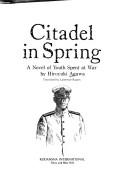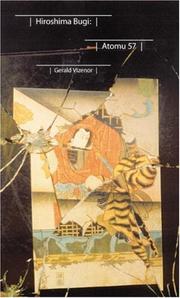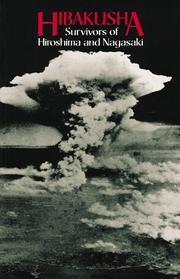| Listing 1 - 10 of 11 | << page >> |
Sort by
|
Book
Year: 1962 Publisher: Liège Paris G. Thone Club du livre sélectionné
Abstract | Keywords | Export | Availability | Bookmark
 Loading...
Loading...Choose an application
- Reference Manager
- EndNote
- RefWorks (Direct export to RefWorks)
Hiroshima --- Hirosjima --- 355.4 : 623.454.9 1945
Book
Year: 1960 Publisher: Tielt Den Haag Lannoo
Abstract | Keywords | Export | Availability | Bookmark
 Loading...
Loading...Choose an application
- Reference Manager
- EndNote
- RefWorks (Direct export to RefWorks)
Guerre mondiale 1939-1945 --- Sciences socialesen Général --- Sociale wetenschappen in 't algemeen --- Wereldoorlog 1939-1945 --- Hiroshima --- Hirosjima --- 355.018 : 623.4 (521.84)

ISBN: 0870119605 4770014600 Year: 1990 Publisher: Tokyo Kodansha international
Abstract | Keywords | Export | Availability | Bookmark
 Loading...
Loading...Choose an application
- Reference Manager
- EndNote
- RefWorks (Direct export to RefWorks)
J5933 --- Japan: Literature -- modern fiction and prose by individual authors (1868- ) --- Hirosjima --- World War, 1939-1945 --- Wereldoorlog II --- verhalen --- Fiction. --- Hiroshima-shi (Japan) --- History --- verhalen. --- Fiction --- Hiroshima --- Hirosima-si (Japan) --- Hiroschima (Japan) --- Khirosima (Japan) --- Hirosjima (Japan) --- Hiroshima (Japan) --- Hiroshimah (Japan) --- Kabe-machi (Japan) --- Asa-chō (Japan) --- Aki-chō (Japan) --- Shiraki-chō (Japan) --- Numata-chō (Hiroshima-ken, Japan) --- Senogawa-chō (Japan) --- Funakoshi-chō (Hiroshima-ken, Japan) --- Hesaka-chō (Japan) --- Itsukaichi-chō (Hiroshima-ken, Japan) --- Nakayama-mura (Hiroshima-ken, Japan) --- Inokuchi-mura (Hiroshima-ken, Japan) --- Verhalen.
Book
ISBN: 0773421041 9780773421042 9780773438156 0773438157 Year: 2010 Publisher: Lewiston, N.Y. Edwin Mellen Press
Abstract | Keywords | Export | Availability | Bookmark
 Loading...
Loading...Choose an application
- Reference Manager
- EndNote
- RefWorks (Direct export to RefWorks)
Crime --- Violence --- Criminal justice, Administration of --- History --- Hiroshima-shi (Japan) --- Poetry. --- Hiroshima --- Hirosima-si (Japan) --- Hiroschima (Japan) --- Khirosima (Japan) --- Hirosjima (Japan) --- Hiroshima (Japan) --- Hiroshimah (Japan) --- Kabe-machi (Japan) --- Asa-chō (Japan) --- Aki-chō (Japan) --- Shiraki-chō (Japan) --- Numata-chō (Hiroshima-ken, Japan) --- Senogawa-chō (Japan) --- Funakoshi-chō (Hiroshima-ken, Japan) --- Hesaka-chō (Japan) --- Itsukaichi-chō (Hiroshima-ken, Japan) --- Nakayama-mura (Hiroshima-ken, Japan) --- Inokuchi-mura (Hiroshima-ken, Japan) --- Crime - Europe - History --- Violence - Europe - History --- Criminal justice, Administration of - Europe - History

ISBN: 0803203470 9780803203471 0803246730 9780803246737 Year: 2003 Publisher: Lincoln : Baltimore, Md. : University of Nebraska Press, Project MUSE,
Abstract | Keywords | Export | Availability | Bookmark
 Loading...
Loading...Choose an application
- Reference Manager
- EndNote
- RefWorks (Direct export to RefWorks)
"Hiroshima Bugi: Atomu 57 is a kabuki novel that begins in the ruins of the Atomic Bomb Dome, a new Rashomon Gate. Ronin Browne, the humane peace contender, is the hafu orphan son of Okichi, a Japanese boogie-woogie dancer, and Nightbreaker, an Anishinaabe from the White Earth Reservation who served as an interpreter for General Douglas MacArthur during the first year of the American occupation in Japan." "Ronin draws on samurai and native traditions to confront the moral burdens and passive notions of nuclear peace celebrated at the peace memorial Museum in Hiroshima. He creates a new calendar that starts with the first use of atomic weapons, Atomu One. Ronin accosts the spirits of the war dead at Yasukuni Jinga. He then marches into the national shrine and shouts to Tojo Hideki and other war criminals to come out and face the spirits of thousands of devoted children who were sacrificed at Hiroshima."--Jacket.
Alienation (Social psychology) --- Japanese --- Indians of North America --- Racially mixed people --- Ethnology --- Hiroshima-shi (Japan) --- Hiroshima --- Hirosima-si (Japan) --- Hiroschima (Japan) --- Khirosima (Japan) --- Hirosjima (Japan) --- Hiroshima (Japan) --- Hiroshimah (Japan) --- Kabe-machi (Japan) --- Asa-chō (Japan) --- Aki-chō (Japan) --- Shiraki-chō (Japan) --- Numata-chō (Hiroshima-ken, Japan) --- Senogawa-chō (Japan) --- Funakoshi-chō (Hiroshima-ken, Japan) --- Hesaka-chō (Japan) --- Itsukaichi-chō (Hiroshima-ken, Japan) --- Nakayama-mura (Hiroshima-ken, Japan) --- Inokuchi-mura (Hiroshima-ken, Japan) --- Multiracial people

ISBN: 433301204X Year: 1986 Publisher: Tokyo Kosei Publishing
Abstract | Keywords | Export | Availability | Bookmark
 Loading...
Loading...Choose an application
- Reference Manager
- EndNote
- RefWorks (Direct export to RefWorks)
First hand accounts of the first victims of nuclear weapons.
History of Asia --- anno 1940-1949 --- Hiroshima --- Nagasaki --- Atomic bomb victims --- 838.1 Ecologie --- 844.5 Gezondheid --- 872 Massavernietigingswapens --- 883.2 Oost-Azië --- A-bomb victims --- Hibakusha --- Victims of atomic bombings --- War victims --- Biography --- Hiroshima-shi (Japan) --- Nagasaki-shi (Japan) --- Nagasaki (Japan) --- Hirosima-si (Japan) --- Hiroschima (Japan) --- Khirosima (Japan) --- Hirosjima (Japan) --- Hiroshima (Japan) --- Hiroshimah (Japan) --- Kabe-machi (Japan) --- Asa-chō (Japan) --- Aki-chō (Japan) --- Shiraki-chō (Japan) --- Numata-chō (Hiroshima-ken, Japan) --- Senogawa-chō (Japan) --- Funakoshi-chō (Hiroshima-ken, Japan) --- Hesaka-chō (Japan) --- Itsukaichi-chō (Hiroshima-ken, Japan) --- Nakayama-mura (Hiroshima-ken, Japan) --- Inokuchi-mura (Hiroshima-ken, Japan) --- History --- Personal narratives.
Book
ISBN: 1108892094 110888055X 1108871879 1108835279 Year: 2021 Publisher: Cambridge : Cambridge University Press,
Abstract | Keywords | Export | Availability | Bookmark
 Loading...
Loading...Choose an application
- Reference Manager
- EndNote
- RefWorks (Direct export to RefWorks)
American Survivors is a fresh and moving historical account of U.S. survivors of the Hiroshima and Nagasaki atomic bombings, breaking new ground not only in the study of World War II but also in the public understanding of nuclear weaponry. A truly trans-Pacific history, American Survivors challenges the dualistic distinction between Americans-as-victors and Japanese-as-victims often assumed by scholars of the nuclear war. Using more than 130 oral histories of Japanese American and Korean American survivors, their family members, community activists, and physicians - most of which appear here for the first time - Naoko Wake reveals a cross-national history of war, illness, immigration, gender, family, and community from intimately personal perspectives. American Survivors brings to light the history of Hiroshima and Nagasaki that connects, as much as separates, people across time and national boundaries.
World War, 1939-1945 --- Americans --- Atomic bomb victims --- Japanese Americans. --- Hiroshima-shi (Japan) --- Nagasaki-shi (Japan) --- History --- Personal narratives, American. --- A-bomb victims --- Hibakusha --- Victims of atomic bombings --- War victims --- Nagasaki (Japan) --- Hiroshima --- Hirosima-si (Japan) --- Hiroschima (Japan) --- Khirosima (Japan) --- Hirosjima (Japan) --- Hiroshima (Japan) --- Hiroshimah (Japan) --- Kabe-machi (Japan) --- Asa-chō (Japan) --- Aki-chō (Japan) --- Shiraki-chō (Japan) --- Numata-chō (Hiroshima-ken, Japan) --- Senogawa-chō (Japan) --- Funakoshi-chō (Hiroshima-ken, Japan) --- Hesaka-chō (Japan) --- Itsukaichi-chō (Hiroshima-ken, Japan) --- Nakayama-mura (Hiroshima-ken, Japan) --- Inokuchi-mura (Hiroshima-ken, Japan)
Book
ISBN: 128282063X 9786612820632 1442207493 9781442207493 9781442207479 1442207477 Year: 2010 Publisher: New York Rowman & Littlefield Publishers
Abstract | Keywords | Export | Availability | Bookmark
 Loading...
Loading...Choose an application
- Reference Manager
- EndNote
- RefWorks (Direct export to RefWorks)
This compelling autobiography tells the life story of famed manga artist Nakazawa Keiji. Born in Hiroshima in 1939, Nakazawa was six years old when on August 6, 1945, the United States dropped the atomic bomb. His gritty and stunning account of the horrific aftermath is powerfully told through the eyes of a child who lost most of his family and neighbors. The narrative continues through the brutally difficult years immediately after the war, his art apprenticeship in Tokyo, his pioneering ""atomic-bomb"" manga, and the creation of Bar
Cartoonists --- Comic books, strips, etc. --- Atomic bomb victims --- Comic strips --- Comics --- Funnies --- Manga (Comic books, strips, etc.) --- Manhua (Comic books, strips, etc.) --- Manhwa (Comic books, strips, etc.) --- Serial picture books --- Caricatures and cartoons --- Wit and humor, Pictorial --- History. --- Nakazawa, Keiji. --- Nakazawa, Keiji --- 中沢啓治 --- 中沢啓治. --- Childhood and youth. --- Family. --- Hiroshima-shi (Japan) --- Japan --- Hiroshima --- Hirosima-si (Japan) --- Hiroschima (Japan) --- Khirosima (Japan) --- Hirosjima (Japan) --- Hiroshima (Japan) --- Hiroshimah (Japan) --- Kabe-machi (Japan) --- Asa-chō (Japan) --- Aki-chō (Japan) --- Shiraki-chō (Japan) --- Numata-chō (Hiroshima-ken, Japan) --- Senogawa-chō (Japan) --- Funakoshi-chō (Hiroshima-ken, Japan) --- Hesaka-chō (Japan) --- Itsukaichi-chō (Hiroshima-ken, Japan) --- Nakayama-mura (Hiroshima-ken, Japan) --- Inokuchi-mura (Hiroshima-ken, Japan) --- History --- Manhua (Comic books) --- Manhwa (Comic books) --- Drawing --- Literature --- Graphic artists --- beeldverhalen
Book
ISBN: 2911716361 9782911716362 Year: 2001 Publisher: Calais Musée des Beaux-Arts et de la Dentelle de Calais
Abstract | Keywords | Export | Availability | Bookmark
 Loading...
Loading...Choose an application
- Reference Manager
- EndNote
- RefWorks (Direct export to RefWorks)
7.07 --- Beeldende kunst ; 2de helft 20ste eeuw ; Marie-Ange Guilleminot --- Vrouwelijke kunstenaars --- Guilleminot, Marie-Ange °1960 (°Saint-Germain-en-Laye, Frankrijk) --- Kunstenaars met verschillende disciplines, niet traditioneel klasseerbare, conceptuele kunstenaars A - Z --- Guilleminot, Marie-Ange --- Bombardment of Hiroshima-shi (Japan : 1945) --- Hiroshima-shi (Japan) --- Hiroshima --- Hirosima-si (Japan) --- Hiroschima (Japan) --- Khirosima (Japan) --- Hirosjima (Japan) --- Hiroshima (Japan) --- Hiroshimah (Japan) --- Kabe-machi (Japan) --- Asa-chō (Japan) --- Aki-chō (Japan) --- Shiraki-chō (Japan) --- Numata-chō (Hiroshima-ken, Japan) --- Senogawa-chō (Japan) --- Funakoshi-chō (Hiroshima-ken, Japan) --- Hesaka-chō (Japan) --- Itsukaichi-chō (Hiroshima-ken, Japan) --- Nakayama-mura (Hiroshima-ken, Japan) --- Inokuchi-mura (Hiroshima-ken, Japan) --- History --- Exhibitions --- Art styles --- Iconography --- Art --- Sculpture --- installations [visual works] --- happenings --- art [fine art] --- wars --- performance art --- textile materials --- sculpting --- anno 1950-1959 --- anno 1960-1969 --- anno 1970-1979 --- anno 1900-1999 --- anno 2000-2099 --- France --- art [discipline]
Book
ISBN: 1316143643 131614366X 1316144089 1316144054 1316143716 1107416590 1316144062 1316144100 1316144070 1107775442 1107071275 1322177406 Year: 2014 Publisher: Cambridge : Cambridge University Press,
Abstract | Keywords | Export | Availability | Bookmark
 Loading...
Loading...Choose an application
- Reference Manager
- EndNote
- RefWorks (Direct export to RefWorks)
In 1962, a Hiroshima peace delegation and an Auschwitz survivor's organization exchanged relics and testimonies, including the bones and ashes of Auschwitz victims. This symbolic encounter, in which the dead were literally conscripted in the service of the politics of the living, serves as a cornerstone of this volume, capturing how memory was utilized to rebuild and redefine a shattered world. This is a powerful study of the contentious history of remembrance and the commemoration of the atomic bomb in Hiroshima in the context of the global development of Holocaust and World War II memory. Emphasizing the importance of nuclear issues in the 1950s and 1960s, Zwigenberg traces the rise of global commemoration culture through the reconstruction of Hiroshima as a 'City of Bright Peace', memorials and museums, global tourism, developments in psychiatry, and the emergence of the figure of the survivor-witness and its consequences for global memory practices.
Collective memory --- Atomic bomb victims --- Memorials --- Peace --- Holocaust, Jewish (1939-1945) --- War victims --- Collective remembrance --- Common memory --- Cultural memory --- Emblematic memory --- Historical memory --- National memory --- Public memory --- Social memory --- Memory --- Social psychology --- Group identity --- National characteristics --- Victims of war --- Victims --- Coexistence, Peaceful --- Peaceful coexistence --- International relations --- Disarmament --- Peace-building --- Security, International --- Commemorations --- Historic sites --- Memorialization --- Monuments --- Political aspects --- Historiography. --- Mental health. --- Hiroshima-shi (Japan) --- Hiroshima --- Hirosima-si (Japan) --- Hiroschima (Japan) --- Khirosima (Japan) --- Hirosjima (Japan) --- Hiroshima (Japan) --- Hiroshimah (Japan) --- Kabe-machi (Japan) --- Asa-chō (Japan) --- Aki-chō (Japan) --- Shiraki-chō (Japan) --- Numata-chō (Hiroshima-ken, Japan) --- Senogawa-chō (Japan) --- Funakoshi-chō (Hiroshima-ken, Japan) --- Hesaka-chō (Japan) --- Itsukaichi-chō (Hiroshima-ken, Japan) --- Nakayama-mura (Hiroshima-ken, Japan) --- Inokuchi-mura (Hiroshima-ken, Japan) --- History --- Moral and ethical aspects.
| Listing 1 - 10 of 11 | << page >> |
Sort by
|

 Search
Search Feedback
Feedback About UniCat
About UniCat  Help
Help News
News